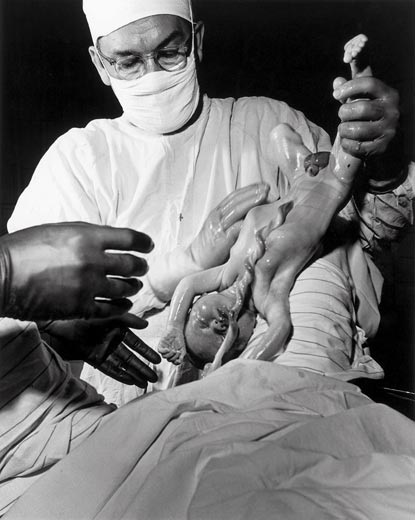Fetal lungs protein triggers labor in term fetus when lungs matured
THURSDAY, JANUARY 03, 2008
Reposted from DrMomma.org
Fetal Lungs Protein Release Triggers Labor to Begin
Babies know when and how to be born.
Each one knows when s/he is ready for life on the outside.
Let’s not rush them.
Let’s trust them.
“We found that a protein within lung, surfactant, serves as a hormone of labor that signals to the mother’s uterus when the fetal lungs are sufficiently mature to withstand the critical transition from life in fluid to airbreathing,” said Mendelson.
“No one really understands what causes normal or preterm labor. There may be several chemical pathways that lead to labor, but we think that this surfactant protein, which is also produced by the fetal lung in humans, may be the first hormonal signal for labor to begin,” reported Mendelson, who is also co-director of the North Texas March of Dimes Birth Defects Center at UT Southwestern.
In humans the signaling protein, called surfactant protein A, or SP-A, also helps immune cells, called macrophages, fight off infections in the lungs of children and adults by gobbling up bacteria, viruses and fungi that infiltrate the lung airway.
“Women who go into preterm labor frequently have an infection of the membranes that surround the fetus, and the number of macrophages in the wall of the uterus increases with the initiation of preterm labor. When women go into labor in their own time, at term, they also have an increase in macrophages in the uterus,” Mendelson said.
This led the researchers to investigate whether there was a connection between what happens during normal labor at term and in infected mothers who go into early labor.
Mendelson continued, “This also raised the question: If bacterial infection can cause increased macrophage infiltration of the uterus in preterm labor, what is the signal for the enhanced macrophage migration to the uterus at term?”
In mice, the developing fetal lung starts producing SP-A at 17 days gestation; full-term delivery occurs at 19 days. The developing human fetus starts producing SP-A in increasing amounts after 32 weeks of a 40+week normal gestation, at which time the baby’s lungs are essentially developed. As the fetus “breathes” amniotic fluid in the womb, the protein is released into the fluid.
“The SP-A protein binds to macrophages in the amniotic fluid, macrophages that come from the fetus itself,” said Dr. Jennifer Condon, a postdoctoral researcher in BioChemistry and the study’s lead author.
The macrophages, activated by the protein, make their way through the amniotic fluid to the wall of the uterus. Once embedded there, they produce a chemical that stimulates an inflammatory response in the uterus, ultimately leading to labor.
Researchers also found that injecting a pregnant mouse with SP-A before day 17 of the pregnancy caused the mouse to deliver early. Injection of pregnant mice with an antibody that blocks SP-A function caused them to deliver late. This would cause us to believe that women who carry babies post 42 weeks (as is common in some family lines) may do so because the necessary SP-A function is happening at later date in gestation (starting at 34 weeks instead of 32 weeks, for example).
Identifying the receptors on the macrophages to which the SP-A protein binds will be the next step, Mendelson said. “We think that bacteria may be binding to the same receptor on the macrophages to cause preterm labor in women. The bacteria mimic the function of SP-A, initiating the chemical reactions that lead to premature labor. If we knew more about this receptor on amniotic fluid macrophages, we may be able to design therapies or inhibitors to block preterm labor.”
Other researchers participating in the study were Dr. Pancharatnam Jeyasuria, a research fellow in internal medicine and former fellow Julie Faust, now a medical student at Texas A&M University.
The research was funded in part by the National Institutes of Health and the Texas Higher Education Coordinating Board.

